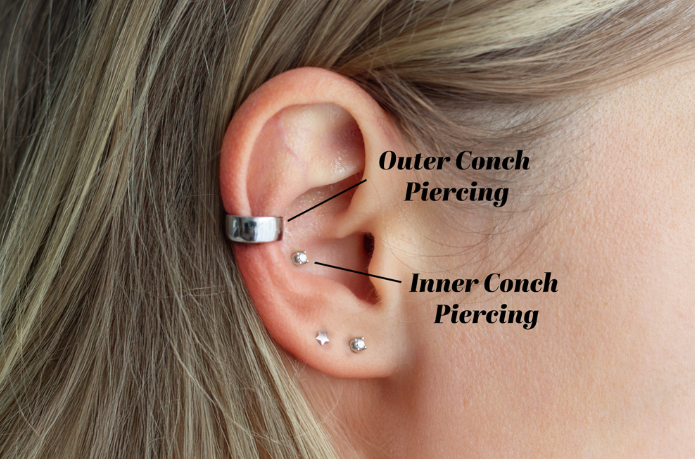A conch piercing is a cartilage piercing placed in the central ear’s concha, requiring precise healing care and correct jewelry sizing. Downsizing refers to replacing the initial longer post or ring with a shorter, snug fit once swelling subsides. The right downsizing time is critical to prevent irritation, bumps, or prolonged healing.
Downsizing in piercing is the process of replacing the original longer jewelry used at the time of piercing with a shorter or smaller piece once initial swelling decreases. Professional piercers insert longer posts, often 5/16 inch (8 mm) or more, to allow room for tissue inflammation. After healing stabilizes, jewelry should be changed to prevent constant movement, snagging, or pressure on the cartilage.
Understanding the definition of downsizing provides the foundation, but knowing why it matters specifically for a conch piercing is the key to preventing long-term complications and ensuring a smooth healing process.

Why Is Downsizing Important for a Conch Piercing?
Now that the importance of downsizing is clear, the next step is determining the right moment in the healing timeline when it should be done to maximize safety and comfort.
There are 5 main reasons downsizing is essential:
-
Prevents irritation bumps – Long posts cause friction, which often leads to hypertrophic scarring.
-
Supports faster healing – Jewelry sitting flush reduces micro-movement, improving tissue repair.
-
Protects cartilage health – Proper fit avoids pressure necrosis and cartilage collapse.
-
Improves comfort – Shorter posts stop snagging on hair, headphones, or masks.
-
Prepares for final styling – Downsizing allows a snug and aesthetic look with hoops or flat-backs.
According to research from the Association of Professional Piercers (APP), improper jewelry sizing increases healing complications by more than 40%.
When Should You Downsize a Conch Piercing?
The best time to downsize a conch piercing is between 8 to 12 weeks after the initial procedure, depending on individual healing.
-
Weeks 1–4: Swelling is highest. Jewelry must remain long enough to accommodate tissue inflammation.
-
Weeks 5–8: Swelling gradually reduces. Piercing stabilizes but remains vulnerable.
-
Weeks 8–12: Most clients are ready for downsizing, provided no irritation or bumps are present.
-
Beyond 12 weeks: If swelling persists or jewelry feels loose, professional assessment is required before downsizing.
Cartilage healing is slower than lobe piercings. Full healing for a conch piercing often takes 6–12 months, but downsizing occurs much earlier to ensure safe healing progression.
Choosing the right moment to downsize is only half of the process. Once swelling decreases, the next step is learning how to recognize the signs that your ear is ready for a jewelry change.
How to Know It Is Time to Downsize?
There are 6 clear signs that indicate readiness for downsizing:
-
Swelling has significantly reduced.
-
Jewelry feels excessively long or protruding.
-
The piercing site is free from active redness or discharge.
-
No sharp tenderness when cleaning or rotating.
-
The bar or ring moves excessively during daily activities.
-
Jewelry catches frequently on clothing or hair.

If multiple of these signs are present, schedule a downsizing appointment.
Jewelry selection influences both healing and aesthetics, yet failing to downsize at the proper stage creates significant risks. This leads to the question of what happens if downsizing is skipped or delayed.
What Jewelry Is Used After Downsizing?
Professional piercers usually replace the long starter bar with:
-
Flat-back labrets: 16G or 14G, with 6 mm–7 mm length.

-
Captive bead rings: downsized to a snug 10 mm–12 mm diameter.

-
Threadless ends: for secure and comfortable fit.

Titanium is the preferred metal due to its biocompatibility, with 316L surgical steel and 14k gold as alternatives.
Our Conch Jewelry collections will align perfectly with your biocompatibility and aesthetic upgrade mention.
What Happens If You Don’t Downsize a Conch Piercing?
The risks of not downsizing show why professional intervention is crucial. To avoid these problems, it is necessary to know how downsizing should be done safely under sterile conditions.
Failing to downsize increases healing risks:
-
Jewelry shifts, creating pressure bumps.
-
Long posts cause embedding or migration.
-
Increased snagging results in tears or trauma.
-
Prolonged healing may extend to 18 months instead of 12 months.
According to a study from the Journal of Body Art Science, improper jewelry fit accounts for over 55% of cartilage piercing complications.
How to Downsize Safely?
Professional downsizing marks the transition to a shorter post, but the healing process does not stop there. After the change, piercees need to follow specific aftercare practices to protect the cartilage and avoid irritation.
Only a professional piercer should perform downsizing. The process includes:
-
Inspection of healing tissue.
-
Sterile removal of original jewelry.
-
Insertion of a shorter bar under aseptic conditions.
-
Cleaning and post-care instructions.
Never attempt self-downsizing at home. Cartilage injuries are slow to heal and can cause permanent deformities.
Aftercare After Downsizing
Consistent aftercare ensures proper tissue recovery, but complications can still arise. This makes it important to understand when to seek professional help if unexpected symptoms occur.
After downsizing, continue the same aftercare until full healing:
-
Clean with sterile saline twice daily.
-
Avoid sleeping on the pierced ear.
-
Do not twist or rotate jewelry.
-
Avoid submerging in pools, hot tubs, or lakes.
-
Maintain a healthy diet to support tissue repair.
Healing remains ongoing even after downsizing. Expect continued sensitivity for months.
When to Seek Professional Help?
See your piercer immediately if:
-
You notice persistent swelling beyond 12 weeks.
-
The jewelry sinks into the tissue (embedding).
-
A painful bump develops on the piercing.
-
Severe redness, heat, or discharge occurs.
Early intervention prevents long-term damage and ensures the piercing heals correctly.
Key Timeline of Downsizing a Conch Piercing
Choosing the right moment to downsize is only half of the process. Once the swelling subsides and timing is confirmed, the next step is identifying how to recognize the signs of readiness and ensuring the jewelry is properly replaced. Understanding these indicators protects your cartilage health and supports faster healing. The following table summarizes the healing timeline and recommended downsizing stages for a conch piercing.
|
Healing Stage |
Weeks |
Piercing Status |
Jewelry Action |
|
Initial swelling |
1–4 |
High inflammation |
Keep long jewelry |
|
Reduced swelling |
5–8 |
Stabilizing, still sensitive |
Monitor, prepare for downsizing |
|
Downsizing window |
8–12 |
Swelling subsided, tissue stable |
Replace with shorter jewelry |
|
Extended healing |
12+ |
Long-term cartilage repair |
Keep snug jewelry, avoid trauma |
FAQs
How painful is downsizing a conch piercing?
Downsizing is mildly uncomfortable but not as painful as the initial piercing.
Can I downsize a conch piercing at 6 weeks?
No, downsizing before 8 weeks risks trapping swelling and slowing healing.
Do all conch piercings need downsizing?
Yes, all initial piercings use longer jewelry, which must be replaced for safe long-term wear.
Can I switch to a hoop during downsizing?
Yes, but only if the piercing shows no irritation. Many piercers recommend waiting until 4–6 months for hoop changes.
What happens if I skip downsizing completely?
Skipping downsizing increases bumps, irritation, and risk of embedding.

